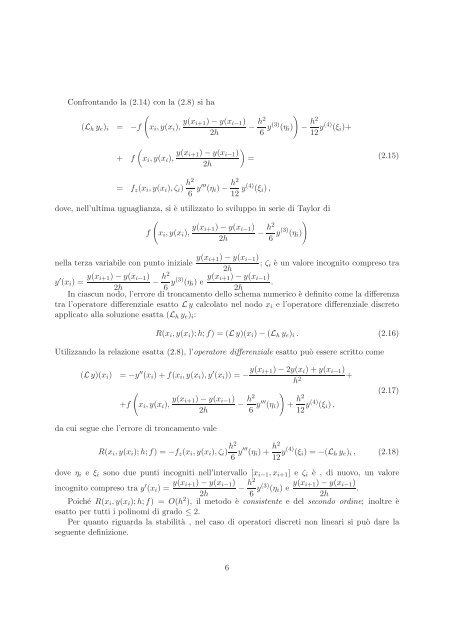problemi ai limiti per equazioni differenziali ordinarie - Sezione di ...
problemi ai limiti per equazioni differenziali ordinarie - Sezione di ...
problemi ai limiti per equazioni differenziali ordinarie - Sezione di ...
Create successful ePaper yourself
Turn your PDF publications into a flip-book with our unique Google optimized e-Paper software.
Confrontando la (2.14) con la (2.8) si ha(L h y e ) i = −f(x i ,y(x i ), y(x i+1) − y(x i−1 )2h(+ f x i ,y(x i ), y(x )i+1) − y(x i−1 )=2h)− h26 y(3) (η i ) − h212 y(4) (ξ i )+(2.15)= f z (x i ,y(x i ),ζ i ) h26 y′′′ (η i ) − h212 y(4) (ξ i ),dove, nell’ultima uguaglianza, si è utilizzato lo sviluppo in serie <strong>di</strong> Taylor <strong>di</strong>(f x i ,y(x i ), y(x )i+1) − y(x i−1 )− h22h 6 y(3) (η i )nella terza variabile con punto iniziale y(x i+1) − y(x i−1 ); ζ i è un valore incognito compreso tra2hy ′ (x i ) = y(x i+1) − y(x i−1 )− h22h 6 y(3) (η i ) e y(x i+1) − y(x i−1 ).2hIn ciascun nodo, l’errore <strong>di</strong> troncamento dello schema numerico è definito come la <strong>di</strong>fferenzatra l’o<strong>per</strong>atore <strong>di</strong>fferenziale esatto L y calcolato nel nodo x i e l’o<strong>per</strong>atore <strong>di</strong>fferenziale <strong>di</strong>scretoapplicato alla soluzione esatta (L h y e ) i :R(x i ,y(x i );h;f) = (L y)(x i ) − (L h y e ) i . (2.16)Utilizzando la relazione esatta (2.8), l’o<strong>per</strong>atore <strong>di</strong>fferenziale esatto può essere scritto come(L y)(x i ) = −y ′′ (x i ) + f(x i ,y(x i ),y ′ (x i )) = − y(x i+1) − 2y(x i ) + y(x i−1 )h 2 ++f(x i ,y(x i ), y(x i+1) − y(x i−1 )2h)− h26 y′′′ (η i ) + h212 y(4) (ξ i ),(2.17)da cui segue che l’errore <strong>di</strong> troncamento valeR(x i ,y(x i );h;f) = −f z (x i ,y(x i ),ζ i ) h26 y′′′ (η i ) + h212 y(4) (ξ i ) = −(L h y e ) i , (2.18)dove η i e ξ i sono due punti incogniti nell’intervallo [x i−1 ,x i+1 ] e ζ i è , <strong>di</strong> nuovo, un valoreincognito compreso tra y ′ (x i ) = y(x i+1) − y(x i−1 )− h22h 6 y(3) (η i ) e y(x i+1) − y(x i−1 ).2hPoiché R(x i ,y(x i );h;f) = O(h 2 ), il metodo è consistente e del secondo or<strong>di</strong>ne; inoltre èesatto <strong>per</strong> tutti i polinomi <strong>di</strong> grado ≤ 2.Per quanto riguarda la stabilità , nel caso <strong>di</strong> o<strong>per</strong>atori <strong>di</strong>screti non lineari si può dare laseguente definizione.6
















